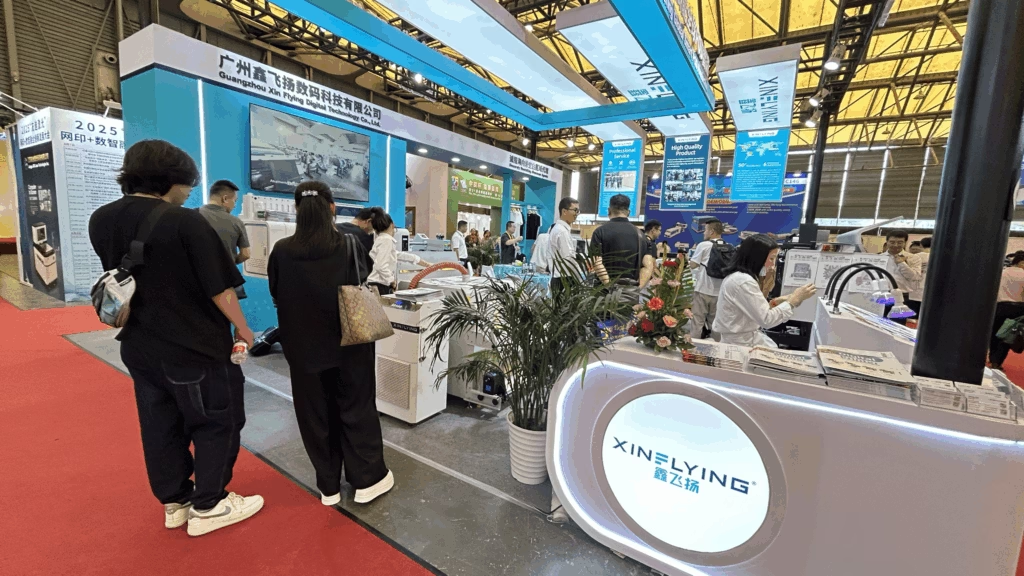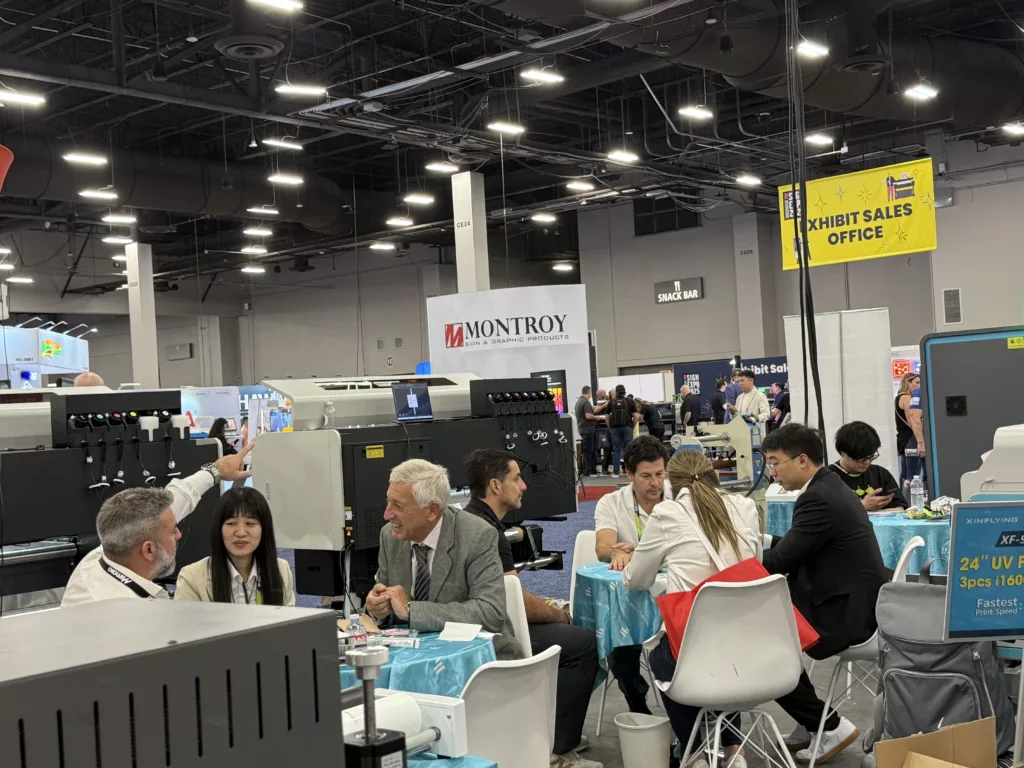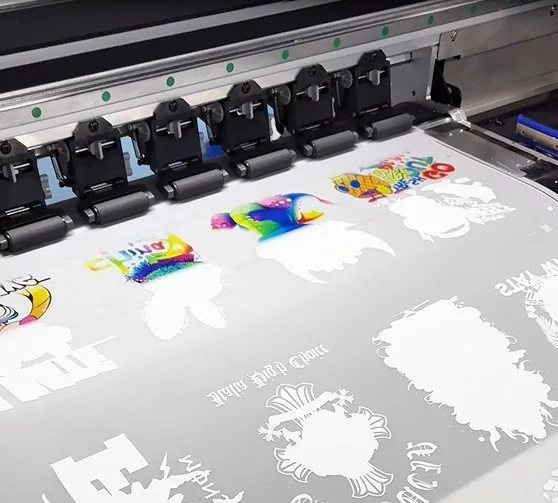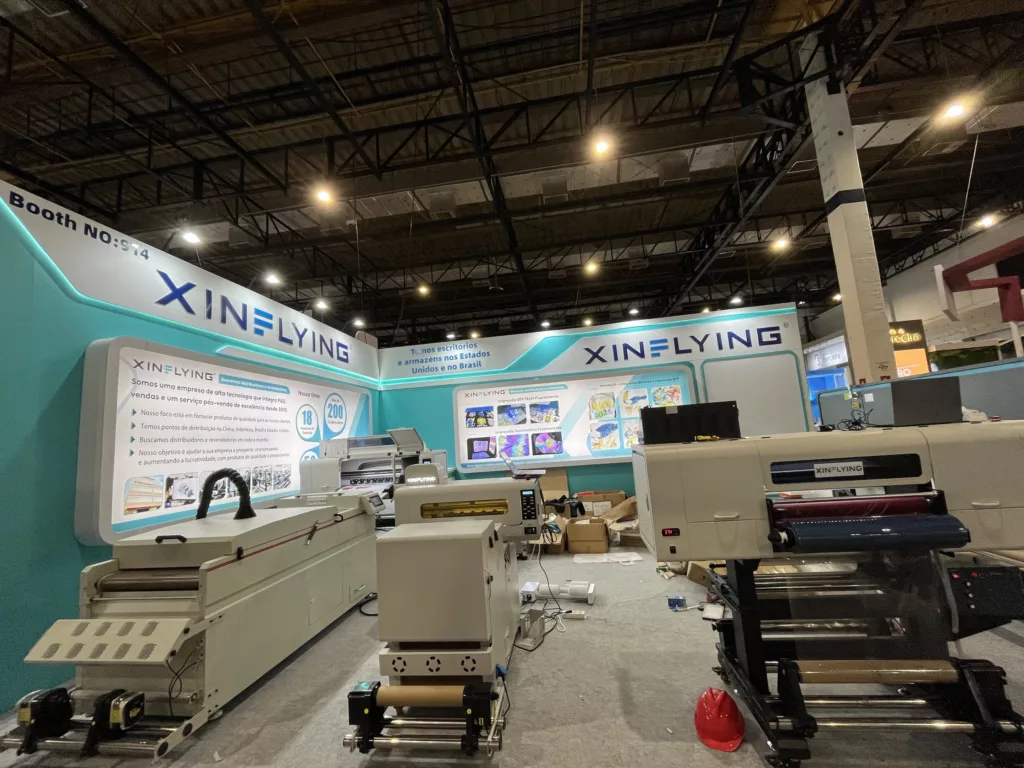A tecnologia de impressão percorreu um longo caminho, Oferecendo vários métodos para dar vida às imagens em diferentes superfícies. Duas técnicas de impressão populares na indústria hoje são impressão UV DTF e impressão dtf. Enquanto os dois métodos oferecem resultados impressionantes, Eles têm características distintas que os diferenciam. Neste artigo, Vamos nos aprofundar nos detalhes de cada método de impressão, Compare seus pontos fortes e limitações, e forneça orientações sobre como selecionar o método de impressão correto para suas necessidades.
O que é impressão UV DTF?
Impressão UV DTF, abreviação de ultravioleta direto para impressão de filmes, é uma tecnologia de ponta que permite transferências de imagem de alta qualidade em vários substratos. Ao contrário dos métodos de impressão tradicionais, Impressão UV DTF emprega ultravioleta (ultravioleta) tintas que são curadas com luz UV para durabilidade excepcional e cores vibrantes.
Como usar a impressora UV DTF?
Etapa 1: Projete no software RIP
Primeiramente, Prepare a obra de arte com software RIP no computador. Em seguida, coloque o UV dtf um filme na plataforma da impressora UV DTF.
Etapa 2: Imprimir em um filme
Pré-encha o cartucho com tinta CMYK, tinta branca, e verniz para imprimir seu desenho no filme UV DTF A.
Etapa 3: Filme B laminado
Coloque o filme impresso na máquina de laminação para grudar com o filme B.
Etapa 4: Coloque filme nos produtos
Retire o filme A do padrão e cole-o no item que deseja imprimir. Em seguida, retire lentamente o filme B, e seu produto está pronto.
Prós e contras da impressão UV DTF

Vantagens da impressão UV DTF
- Alta qualidade de imagem e nitidez
A impressão UV DTF oferece qualidade de imagem excepcional com detalhes nítidos e cores vibrantes. As tintas UV têm uma ampla gama de cores, permitindo uma reprodução precisa de cores.
- Ampla gama de cores
A impressão UV DTF permite que uma ampla gama de cores seja impressa em vários substratos, resultando em designs ricos e vibrantes.
- Tempo de produção rápido
Comparado aos métodos de impressão tradicionais, A impressão UV DTF oferece tempos de produção mais rápidos. As tintas UV secam quase instantaneamente, eliminando a necessidade de períodos de secagem prolongados.
- Capacidade de imprimir em vários substratos
A impressão UV DTF fornece a flexibilidade de imprimir em uma ampla gama de materiais, incluindo tecidos, plásticos, vidro, e mais. Essa versatilidade o torna a escolha ideal para as empresas que desejam diversificar suas ofertas de produtos.
Limitações da impressão UV DTF
- Custo das tintas UV e equipamentos
A impressão UV DTF requer tintas UV especializadas e equipamentos, o que pode ser mais caro em comparação com os materiais de impressão tradicionais. Adicionalmente, As tintas UV podem ter uma vida útil mais curta, exigindo substituições frequentes.
- Flexibilidade limitada com determinados materiais
Enquanto a impressão UV DTF pode ser aplicada a vários substratos, Alguns materiais podem não ser adequados devido à sua textura ou composição da superfície. É importante testar a impressão em diferentes materiais antes de se comprometer com a produção em larga escala.
- Requisitos de manutenção e manutenção
O equipamento de impressão UV DTF requer manutenção e manutenção regulares para garantir um desempenho consistente. Isso inclui limpar as cabeças da impressora e garantir condições ideais para a cura UV.
O que é impressão DTF?
Impressão DTF, ou Impressão direta para o filme, é uma técnica que envolve a impressão de designs em um filme usando tintas especializadas, que são posteriormente transferidos para o substrato desejado.
Como usar a impressora DTF?
Etapa 1: Projete no software RIP
Semelhante à impressão UV DTF, projetar a obra de arte usando o software de design gráfico, Garantir o design desejado e a qualidade da imagem são alcançados.
Etapa 2: Imprimir no filme de estimação
Insira o filme de estimação no impressora DTF bandejas e comece a imprimir. Então o padrão de design será transferido para ele.
Etapa 3: Tinta de ligação com pó
Com uma máquina de agitação de pó, o Pó adesivo DTF pode se espalhar uniformemente no filme de estimação e secar os gráficos.
Etapa 4: Padrão de Transferência em Têxtil
Coloque o filme de estimação DTF no topo do substrato e transfira o design usando a máquina de prensa de calor.
Prós e contras da impressão DTF
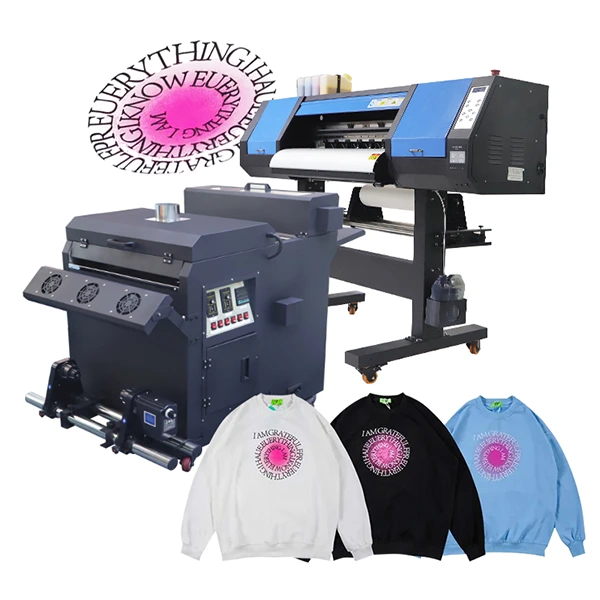
Vantagens da impressão DTF
- Método de impressão econômico
A impressão DTF é considerada econômica, Principalmente devido aos seus custos mais baixos de equipamento e tinta em comparação com a impressão UV DTF. Isso o torna acessível a pequenas empresas e indivíduos que desejam se aventurar na indústria de impressão.
- Versatilidade em termos de substratos compatíveis
Como impressão uv dtf, A impressão DTF permite imprimir em vários substratos, incluindo tecidos, cerâmica, plásticos, e mais. Essa versatilidade expande a gama de produtos que podem ser produzidos usando a impressão DTF.
- Capacidade de obter cores vibrantes e detalhes finos
A impressão DTF pode obter cores vibrantes e vívidas, bem como detalhes finos, tornando -o adequado para desenhos complexos e obras de arte complexas.
- Fácil de usar e limpar
As impressoras DTF são fáceis de usar, exigindo configuração e manutenção mínimas. Adicionalmente, O processo de limpeza é relativamente simples, permitindo operação mais suave e tempo de inatividade reduzido.
Limitações da impressão DTF
- Gama de cores limitada em comparação com UV DTF
Enquanto a impressão DTF pode obter cores vibrantes, Sua gama de cores pode ser mais estreita em comparação com UV DTF, limitando a gama de tons e tons que podem ser reproduzidos.
- Tempo de produção mais longo
A impressão DTF pode exigir etapas adicionais para transferir o design para o substrato, o que pode resultar em tempos de produção mais longos em comparação com a impressão UV DTF.
- Pode exigir etapas adicionais para determinados tecidos
Certos tecidos podem exigir processos de pré-tratamento antes de imprimir com Tintas DTF. Isso pode adicionar complexidade e tempo ao processo de impressão geral.
DTF UV versus DTF: Uma comparação
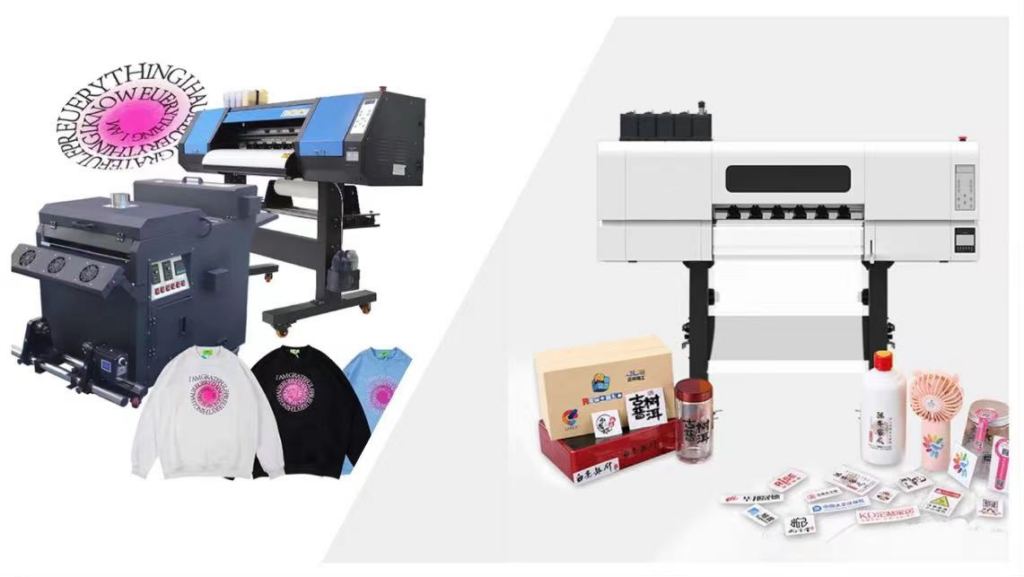
A. Comparação de qualidade de impressão
Resolução e nitidez
A impressão UV DTF e DTF pode obter impressões de alta resolução com detalhes nítidos. No entanto, A impressão UV DTF pode oferecer resultados um pouco mais nítidos devido ao processo de cura UV, O que aumenta a permanência da tinta.
Precisão de cores e vibração
A impressão UV DTF geralmente oferece uma gama de cores mais ampla, permitindo reprodução de cores mais precisa e designs vibrantes. Impressão DTF, Embora capaz de cores vibrantes, pode ter limitações para alcançar certos tons e tons.
B. Tipos de substratos
Opções de tecido
A impressão UV DTF e DTF pode ser usada para imprimir em vários tipos de tecidos, incluindo algodão, poliéster, e misturas. No entanto, A impressão DTF pode exigir etapas adicionais ou pré-tratamento para determinados tecidos para garantir a adesão ideal de tinta.
Impressão em superfícies duras
Quando se trata de imprimir em superfícies duras, como vidro, plástico, ou cerâmica, A impressão UV DTF é a escolha preferida. O processo de cura UV garante excelente aderência e durabilidade da tinta nessas superfícies.
C. Velocidade de produção e eficiência
A impressão UV DTF oferece tempos de produção mais rápidos em comparação com a impressão DTF. A secagem instantânea das tintas UV DTF elimina a necessidade de períodos de secagem prolongados, permitindo um fluxo de trabalho mais eficiente.
D. Comparação de custos
A impressão UV DTF geralmente possui custos antecipados mais altos devido às tintas UV especializadas e equipamentos necessários. Impressão DTF, por outro lado, oferece um ponto de entrada mais econômico para aqueles que iniciam seus
Impressão de empreendimentos.
E. Requisitos de manutenção e manutenção
O equipamento de impressão UV DTF e DTF requer manutenção e manutenção regulares. No entanto, As impressoras UV DTF podem exigir limpezas e substituições de tinta mais frequentes devido à natureza das tintas UV.
Dtf vs uv dtf, Qual é melhor?
| Tipo | Impressão DTF | Impressão UV DTF |
| Tecnologia | Imprime em um filme que é então pressionado pelo calor no material. | Combina a tecnologia DTF com luz UV para curar instantaneamente a tinta. |
| Tinta | Usa cmyk+ tinta branca, Impresso em um filme de estimação claro. | Usa tinta UV, Impresso em um filme de estimação claro. |
| Aplicativo | Algodão, poliéster, Misturas de algodão-poli, couro, nylon, e mais. | Algodão, poliéster, Misturas de algodão-poli, couro, nylon, plástico, madeira, metal, e até vidro, e mais. |
| Detalhe | Qualidade e detalhe de imagem muito alta. | Alta qualidade de imagem e detalhes, Embora o processo UV possa afetá -lo levemente. |
| Durabilidade | Altamente durável, mas pode não durar tanto quanto o UV DTF. | Altamente durável, O processo UV estende a longevidade impressa. |
Tabela de comparação DTF vs UV DTF
Quando escolher a impressão UV DTF
A impressão UV DTF é uma escolha adequada para empresas ou indivíduos que procuram impressões de alta qualidade com cores vibrantes e detalhes nítidos. É ideal para quem prioriza tempos de produção mais rápidos, precisam de impressão em superfícies duras, e pode acomodar os custos mais altos iniciais.
Quando escolher a impressão DTF
A impressão DTF é uma opção econômica para quem está que inicia na indústria de impressão. Oferece versatilidade em termos de substratos compatíveis e é relativamente fácil de usar e manter. DTF printing is recommended for those who prioritize cost efficiency, versatility in printing materials, and simplicity in operation.
Selecting the Right Printing Method

Desired Print Quality
Consider the level of image sharpness, precisão de cores, and vibrancy required for your prints. UV DTF printing excels in these areas, while DTF printing offers a more cost-effective option with respectable print quality.
Type of Materials to Be Printed on
Take into account the diversity of substrates you plan to print on. If you anticipate a need for printing on hard surfaces or materials that may require pre-treatment, UV DTF printing is the better choice.
Production Quantities and Deadlines
If you have strict production deadlines or high-volume printing requirements, UV DTF printing’s fast production time may be more suitable. No entanto, Se as quantidades de produção não são uma preocupação principal, A impressão DTF oferece uma alternativa capaz.
Orçamento disponível
Considere seu orçamento disponível para equipamento, tintas, e manutenção. A impressão UV DTF geralmente requer um investimento mais alto, Enquanto a impressão DTF apresenta um ponto de entrada mais econômico. Também, É importante escolher um fabricante confiável de impressoras de tecido.
Conclusão
Para concluir, Impressão UV DTF e impressão DTF são dois métodos distintos que oferecem qualidade e versatilidade excepcionais da imagem.
A impressão UV DTF se destaca em termos de cores vibrantes, detalhes nítidos, e a capacidade de imprimir em vários substratos, tornando -o ideal para empresas com alocações de orçamento mais altas e necessidades de impressão específicas. Impressão DTF, por outro lado, Fornece um ponto de entrada econômico para pequenas empresas e indivíduos que buscam versatilidade, simplicidade, e facilidade de uso.
Em última análise, A escolha entre a impressão UV DTF e a impressão DTF depende de fatores como requisitos de impressão, Diversidade de substratos, Quantidades de produção, e orçamento disponível. Considerando esses fatores e compreendendo os pontos fortes e limitações de cada método, Você pode tomar uma decisão informada e obter excelentes resultados de impressão.



























